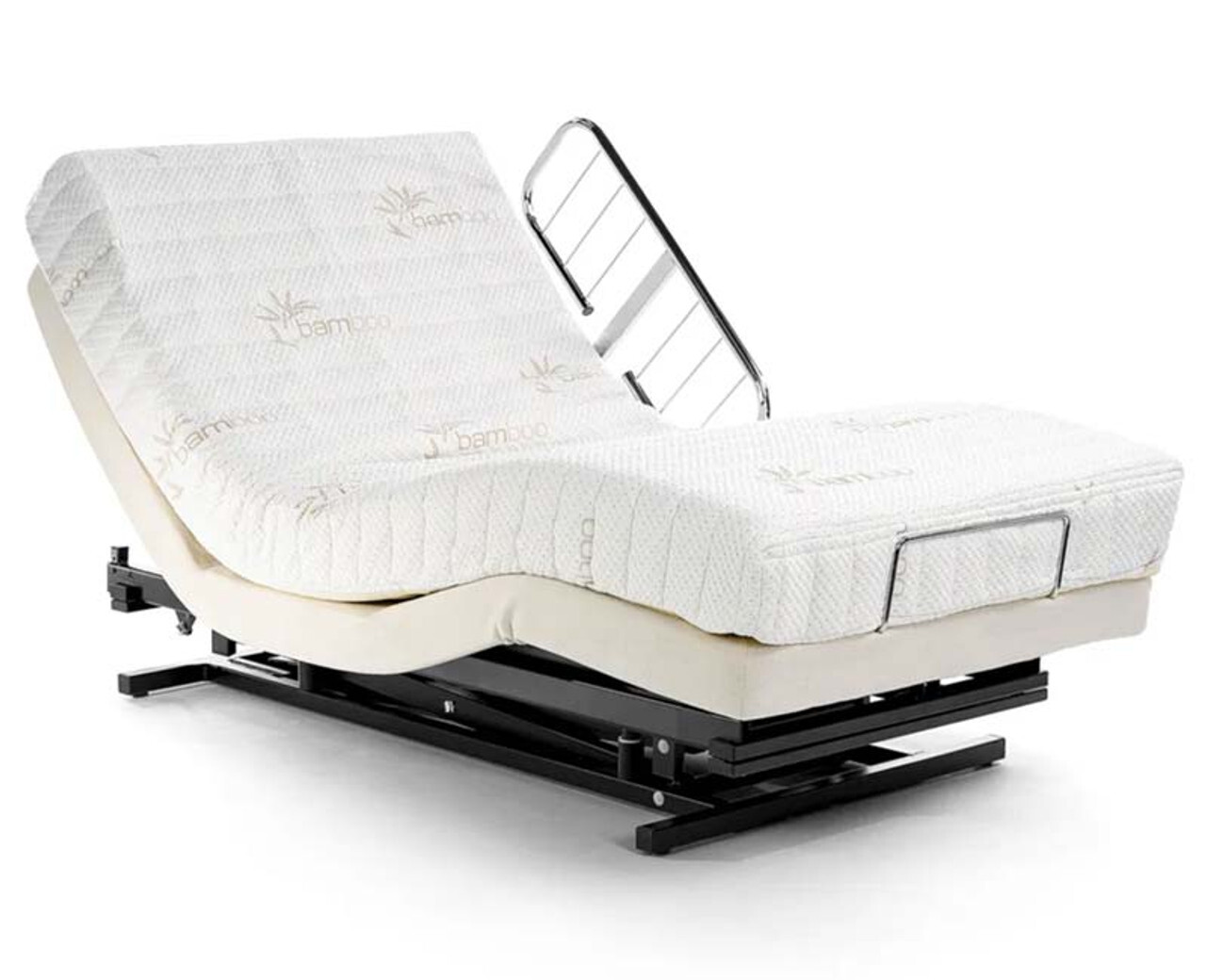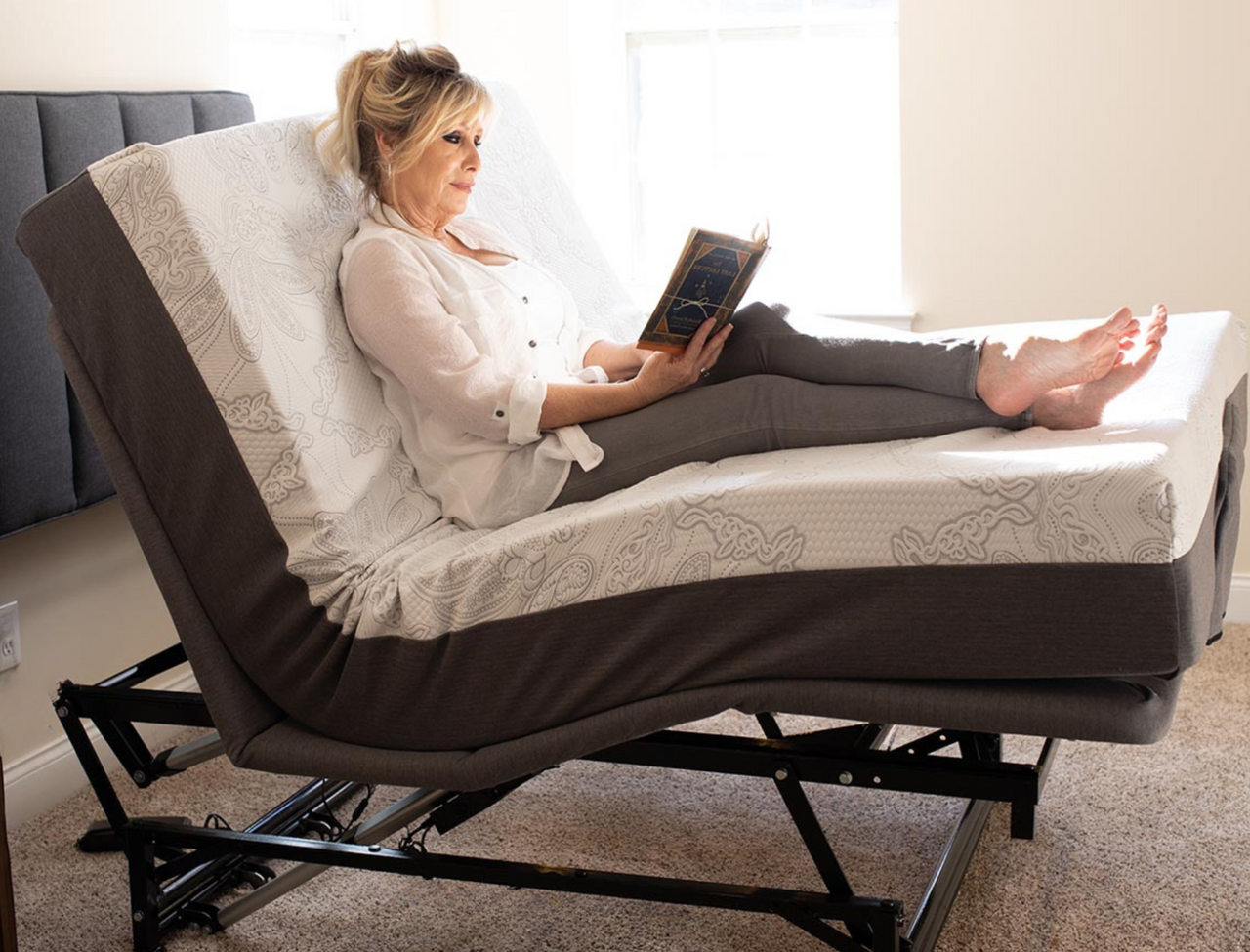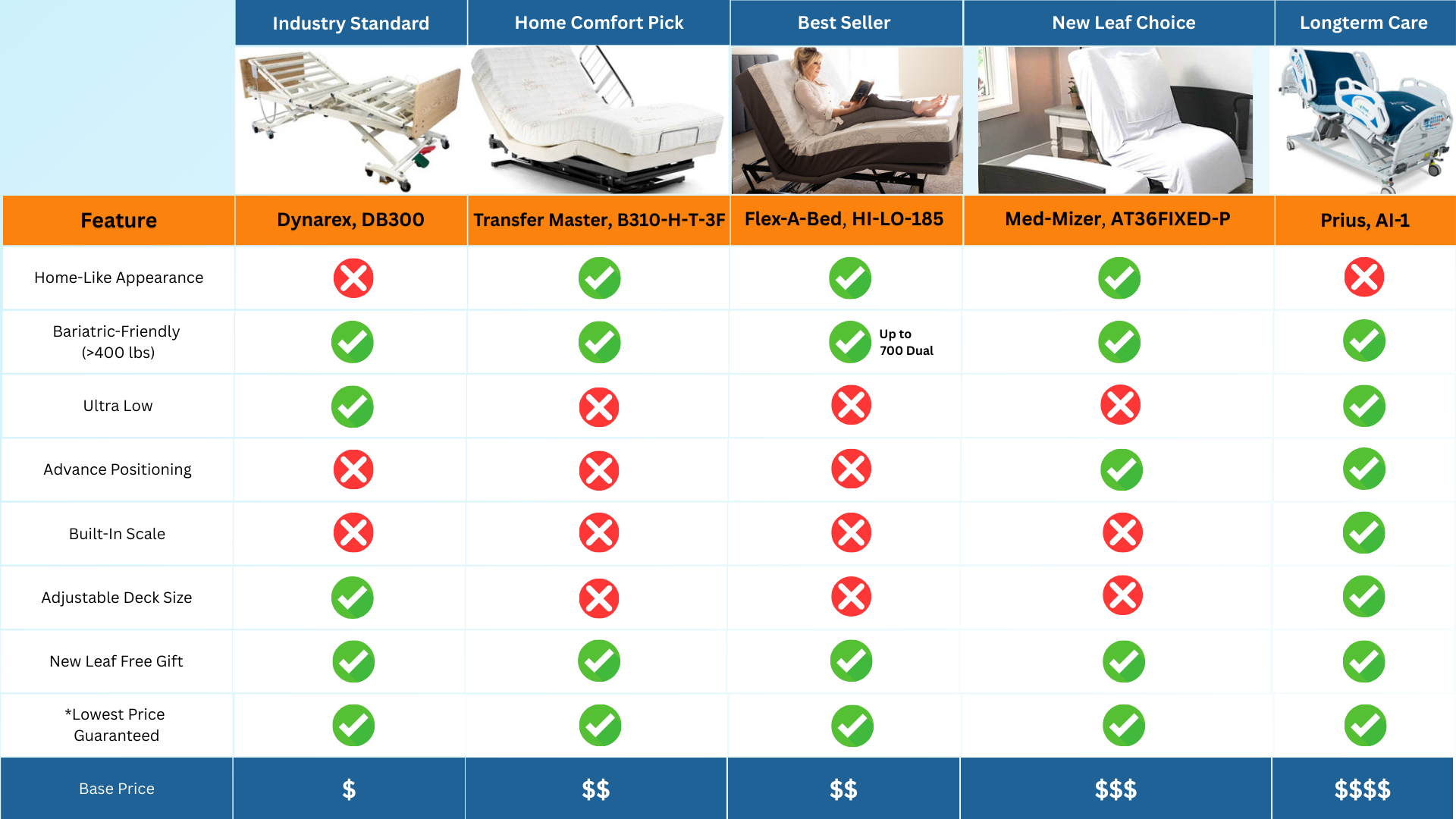FREE SHIPPING ON ORDERS OVER $75
5 Different Types of Hospital Beds for Home

Selecting the right hospital bed for home use is a crucial decision that directly impacts comfort, safety, and recovery for individuals with health challenges. Whether it's for an elderly family member, someone recovering from surgery, or managing chronic conditions, having the proper support at home can transform their quality of life. Hospital beds designed for home care offer varied features that address specific needs, ensuring ease of movement, support for caregivers, and a conducive environment for healing.
With so many options available, from adjustable to long-term grade and bariatric beds, understanding the unique advantages of each type helps tailor the choice to the user’s requirements. This guide will take you through the different types of hospital beds available for home use, outlining the essential factors to consider to ensure that you or your loved one has a bed that meets all physical, comfort, and care needs.
Understanding The Different Types of Hospital Beds
Finding the right hospital bed is about aligning features with needs. Hospital beds designed for home care come in a variety of types, each suited to different requirements based on mobility, comfort, and medical assistance levels.
Adjustable Beds
 Adjustable beds are one of the most versatile types available for home use. These beds offer flexibility, allowing for head, leg, and overall height adjustments to fit the user’s comfort and health requirements. With adjustable beds, individuals can change positions, which helps prevent bed sores and eases discomfort.
Adjustable beds are one of the most versatile types available for home use. These beds offer flexibility, allowing for head, leg, and overall height adjustments to fit the user’s comfort and health requirements. With adjustable beds, individuals can change positions, which helps prevent bed sores and eases discomfort.
Benefits:
- Enhanced Comfort: Adjustable beds allow users to raise or lower parts of the bed for personalized comfort.
- Health Improvement: Adjustments can help reduce pressure points, improving circulation and reducing the risk of ulcers.
- Mobility Aid: The flexibility of adjustable beds assists with easier transfers and getting in and out of bed, a crucial benefit for those with mobility issues.
Long-term Grade Care Beds for Intensive Needs
 Long-term care beds are designed with critical care features but can also be adapted for home care in cases where patients require high levels of medical support. While Long-term care beds are typically found in s, some individuals with complex health needs may opt for a Long-term grade care bed at home.
Long-term care beds are designed with critical care features but can also be adapted for home care in cases where patients require high levels of medical support. While Long-term care beds are typically found in s, some individuals with complex health needs may opt for a Long-term grade care bed at home.
Benefits:
- Advanced Medical Support: These beds often come with features like side rails, emergency settings, and precise positioning to assist in intensive care.
- Durability: Built to support patients requiring high attention, Long-term care beds are robust and can handle frequent use and adjustments.
- Health Monitoring: Some long-term care beds may include or allow integration with health monitoring devices.
Standard Hospital Beds
 For individuals who need basic support, standard hospital beds offer a straightforward and cost-effective solution. These beds are typically manual or semi-electric, allowing the user or caregiver to adjust the bed as needed without the complexity or cost of advanced features.
For individuals who need basic support, standard hospital beds offer a straightforward and cost-effective solution. These beds are typically manual or semi-electric, allowing the user or caregiver to adjust the bed as needed without the complexity or cost of advanced features.
Benefits:
- Cost-Effective: Standard hospital beds are generally more affordable, making them ideal for temporary needs.
- Simple and Functional: They provide essential adjustments like head and foot elevation, which may be sufficient for those needing only basic support.
- Sturdy Design: Standard beds are built for long-term reliability without extra features that could complicate usage.
Bariatric Beds for Weight Support
Bariatric beds are specially designed to support individuals with higher weight capacities. These beds are wider and more durable, providing a comfortable space and enhanced stability. Bariatric beds are ideal for users who need extra support and a larger sleeping area.
Benefits:
- Increased Capacity: Bariatric beds support higher weight limits, accommodating individuals who need added strength and support.
- Comfortable Space: With a wider design, bariatric beds offer more room for comfortable movement and positioning.
- Enhanced Safety Features: These beds often include reinforced frames and additional safety measures, such as side rails, to prevent falls.
Specialized Beds for Unique Needs
 For certain health conditions, specialized hospital beds may be the best option. These can include rotating beds, low beds, and high-low beds, each tailored to address specific health requirements or mobility challenges.
For certain health conditions, specialized hospital beds may be the best option. These can include rotating beds, low beds, and high-low beds, each tailored to address specific health requirements or mobility challenges.

Benefits:
- Customizable Support: Specialized beds are tailored for conditions that require particular support, such as limited movement or heightened risk of falls.
- Health-Specific Features: High-low beds allow for height adjustments that ease transfers, while rotating beds assist with repositioning to prevent bedsores.
- Better Access for Caregivers: The custom features in specialized beds make it easier for caregivers to provide assistance, enhancing safety and comfort.
Manual vs. Electric Hospital Beds
The choice between a manual and an electric bed is a pivotal one, as it impacts the level of independence and ease of use. Each has its advantages, depending on the user’s physical capabilities and preferences.
Manual Hospital Beds
Manual hospital beds require physical effort to adjust the bed’s positioning. These are usually adjusted with a hand crank, which may require assistance from a caregiver.
- Cost-Effective Option: Manual beds are generally less expensive, making them ideal for those on a budget or with short-term needs.
- Simple to Maintain: With fewer electronic components, manual beds are less prone to technical issues and are easy to maintain.
- Ideal for Limited Adjustments: These beds are best suited for patients who don’t need frequent adjustments.
Electric Hospital Beds
Electric beds are powered by a motor and allow users or caregivers to adjust the bed at the touch of a button. This added convenience can be life-changing for those who require frequent repositioning.
- Ease of Use: Electric adjustments make it easy for the user to change positions independently, enhancing comfort and mobility.
- Improved Accessibility: Electric beds are ideal for individuals with limited strength or dexterity, enabling them to control the bed’s position without assistance.
- Frequent Adjustment Friendly: For users who need regular repositioning, electric beds provide the flexibility and ease required to adjust as needed.
Semi-Electric Hospital Beds: A Balance of Cost and Convenience
Semi-electric beds combine manual and electric adjustments, offering a middle-ground solution. While the bed frame height is manually adjusted, the head and foot can be electrically controlled.
- Affordability Meets Comfort: Semi-electric beds are more affordable than fully electric models but provide essential convenience.
- Reduced Caregiver Strain: Caregivers benefit from electric adjustments for frequently adjusted positions, like head and foot elevation.
- Reliability and Ease: These beds offer a balanced option for users needing occasional, not constant, adjustments.
Choosing the Best Hospital Bed Type for Home Care
Selecting the right hospital bed for home care depends on various factors, from health needs to budget constraints. Here’s a quick overview of which bed types may be best suited for different situations.
- For Mobility Support: Adjustable beds and electric beds allow users to get in and out of bed with ease, reducing fall risks.
- For Intensive Medical Care: Long-term Care Bed, while costly, provide advanced features for individuals requiring close medical supervision.
- For Comfort and Space: Bariatric beds provide extra space and stability, making them ideal for individuals who need a wider bed with additional weight support.
- For Budget-Friendly Options: Standard manual beds offer the essential features without added costs, making them suitable for temporary or lower-maintenance needs.

Overview of Costs and Budget-Friendly Options
Cost is an important factor in choosing a hospital bed for home use. Prices can vary significantly based on bed type, additional features, and brand.
Price Ranges by Type
- Manual Beds: Typically the most affordable, manual beds can range from $500 to $1,500, depending on size and brand.
- Electric Beds: These range from $1,000 to $3,500 due to the electric mechanisms and increased flexibility.
- Bariatric Beds: Prices start around $2,500 and can reach $5,000 or more for high-capacity models.
- Specialized and Long-Term Care Beds: These can range significantly but often start around $3,000 and go up depending on the level of medical features included.
Final Thoughts
Choosing a hospital bed for home care is about more than selecting a piece of furniture; it's about creating a supportive environment that fosters comfort, safety, and peace of mind. The right bed can provide necessary relief, facilitate recovery, and enhance the daily life of those with health concerns. From cost-effective manual beds to specialized options for intensive care needs, each type serves a unique purpose, allowing for customized support that adapts to specific health and lifestyle requirements.
Ultimately, by evaluating individual needs and understanding the features of each bed type, you can make a well-informed decision that will positively impact both the user and their caregivers. With the right hospital bed, home becomes a place of care and comfort, enabling a smoother journey toward health and well-being.
